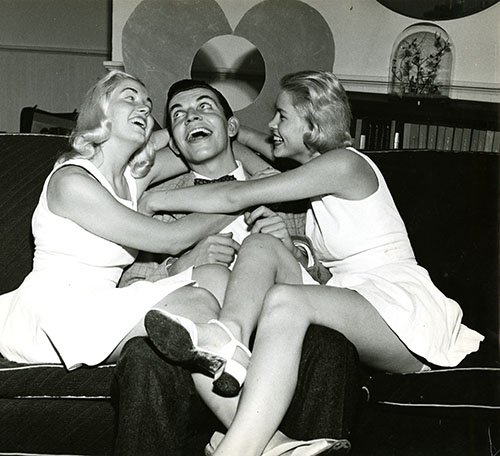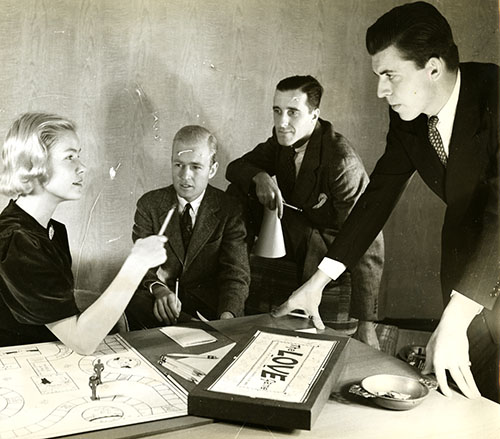[slideshow_deploy id=’9141′]
As we now experience the shutdown due to the COVID-19 pandemic, many of us in self-quarantine, our thoughts turn to those who are essential to caring for those afflicted by the deadly virus. Doctors, nurses, EMTs, hospital workers and others in the medical fields are providing services for the sick and selflessly keeping us all safe. People across the country are rightly acknowledging and thanking them for their devotion to their work and to our well-being.
In the scheme of things at this moment in time the work of archivists seems pretty inconsequential, although my colleagues and I will contend that any event that we are dealing with in the present can, and should, be looked at through the lens of history. So that’s where we come in. That’s what we do.
The UConn Archives has an ample number of resources about the tireless work of those who care for others.
We hold an extensive number of collections on the history of nursing, many of which provide context and support to the materials found in the University of Connecticut School of Nursing Archives. This area is particularly strong in its documentation of the professional development, status, and legal activities associated with nursing by the organizations in Connecticut on behalf of their members as well as 20th century nurse training. There is limited, but significant, documentation of information on 19th century nursing activities during the American Civil War in the Josephine Dolan Collection. Formats accepted include manuscripts, diaries, correspondence, photographs, ephemera, sound recordings, and moving images. More information about these collections can be found in our collection management system at https://archivessearch.lib.uconn.edu/repositories/2/classifications/9 but a few of the more significant collections are highlighted here:
UConn School of Nursing Records. As early as 1937, public health personnel in the state explored the possibility of organizing courses for public health nurses at Connecticut State College but, lacking funds, the project was shelved. In 1940, a committee of 18 members was formed and in 1941 presented a report entitled “A School of Nursing for Connecticut.” The proposal envisaged a program for registered nurses leading to the Bachelor of Science degree and a curriculum which would include 33 to 36 credits in required general courses plus a major in Nursing Education, School Nursing/Health Teaching or Public Health Nursing. The newly created University of Connecticut (named changed in 1939) Administration decided that a School of Nursing that would provide basic preparation in nursing as well as curricula for registered nurses would meet the need expressed in the report. The new School of Nursing was established in Fall 1942; the first Dean, Carolyn Ladd Widmer, was appointed in July, 1942, and arrived on campus in August. The finding aid to the collection can be found at https://archivessearch.lib.uconn.edu/repositories/2/resources/668
UConn School of Nursing War Veteran Oral History Collection, of interviews with nurses who served during military conflicts: http://hdl.handle.net/11134/20002:20100100
Josephine A. Dolan Collection of Nursing History consists of materials gathered by Dolan, the first nursing professor at the University of Connecticut School of Nursing, consisting primarily of correspondence of the Wolcott family, articles and proceedings of various nursing organizations.https://archivessearch.lib.uconn.edu/repositories/2/resources/346. Items related to wartime nursing and the Wolcott family can be found in the digital repository at http://hdl.handle.net/11134/20002:199500288
Ona M. Wilcox School of Nursing, of records associated with this nursing school affiliated with Middlesex Hospital in Middletown — https://archivessearch.lib.uconn.edu/repositories/2/resources/923
Connecticut Nurses’ Association Records — https://archivessearch.lib.uconn.edu/repositories/2/resources/311
Connecticut League for Nursing History — https://archivessearch.lib.uconn.edu/repositories/2/resources/310
Connecticut Training School for Nurses Records, first school for nurses in Connecticut, open from 1873 to 1926 — https://archivessearch.lib.uconn.edu/repositories/2/resources/331
Eastern Nursing Research Society Records — https://archivessearch.lib.uconn.edu/repositories/2/resources/360
North East Organization for Nursing Records — https://archivessearch.lib.uconn.edu/repositories/2/resources/555
Meriden-Wallingford Hospital School of Nursing Records — https://archivessearch.lib.uconn.edu/repositories/2/resources/542
Eleanor Herrmann Nursing History Collection; professor of nursing at UConn from 1987 to 1997 and a member of the American Association for the History of Nursing, was one of its past presidents, and served on editorial boards and review panels for several professional journals. She also was a member of Sigma Theta Tau Nursing Honor Society; a fellow of the American Academy of Nursing — https://archivessearch.lib.uconn.edu/repositories/2/resources/43
The digital repository has a large number of photographs of the 2016 School of Nursing Commencement, available beginning here: https://collections.ctdigitalarchive.org/islandora/search/nursing%20commencement?type=edismax&cp=20002%3AUniversityofConnecticut
Records of the UConn Health Center. Founded in 1961 the University of Connecticut Health Center is composed of the School of Medicine and School of Dental Medicine, John Dempsey Hospital, the UConn Medical Group and University Dentists pursues a mission of providing outstanding health care education in an environment of exemplary patient care, research and public service. The Health Center’s main campus is situated in Farmington, Connecticut. The finding aid to the Heath Center records can be found at https://archivessearch.lib.uconn.edu/repositories/2/resources/713
UConn Health Board of Directors Records — http://hdl.handle.net/11134/20002:19970129BOD
Oral History interviews of those familiar with the early history of the Health Center — http://hdl.handle.net/11134/20002:19970129OH
UConn Health Center Library’s publication Update, 1995-2002: http://hdl.handle.net/11134/20004:19970129Update
UConn School of Medicine:
Faculty Forums, 2006-2020 — http://hdl.handle.net/11134/20002:19970129FF
School of Medicine Governance — http://hdl.handle.net/11134/20002:19970129SOMResCouncil
Records of the UConn School of Pharmacy. The Connecticut College of Pharmacy was established in 1925 and located in New Haven, Connecticut. the course in pharmacy was extended from two to three years (1927) and to four years in 1932 (B.S. degree). In 1941, the Connecticut General Assembly incorporated the College as a School of the University of Connecticut. Beginning in 1942 diplomas were awarded in Storrs rather than in independent ceremonies at Yale University as had been the practice to date. In 1951, the School moved to the Storrs Campus of the University of Connecticut. The collection contains an extensive collection of clippings (scrapbooks) concerning the program and its faculty, students and graduates in addition to historical papers, documents and reports about pharmacy and the program at the University. The finding aid to the collection can be found at https://archivessearch.lib.uconn.edu/repositories/2/resources/592 and a small number of items associated with the School of Pharmacy are in the digital repository at http://hdl.handle.net/11134/20004:19930077
Other collections touching on medical issues:
George W. Hanford correspondence from World War I. Hanford worked in the medical corps in the war and wrote to his parents in Kensington, Connecticut. The letters, from 1917 to 1918, can be found at http://hdl.handle.net/11134/20002:20050140












